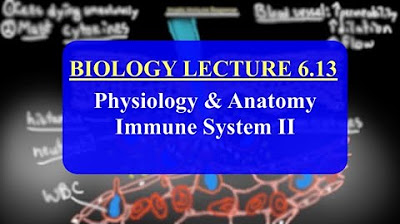(209) Inflammation, B cells and Antibodies
Summary
TLDRThis transcript delves into the intricacies of the immune system, explaining the roles of innate and adaptive immunity in responding to pathogens. It highlights the immediate, non-specific defense mechanisms of the innate immune system, such as macrophages, neutrophils, and cytokine release, which initiate inflammation. The adaptive immune system, characterized by its highly specific response, involves B and T lymphocytes, antibody production, and clonal selection. The transcript also touches on how the innate system aids the adaptive immune response, and how vaccines can trigger similar immune reactions. In addition, the text covers various immune system components like interferons, NK cells, and the role of fever in pathogen defense.
Takeaways
- 😀 Innate immunity is the body’s immediate, non-specific response to pathogens, whereas adaptive immunity is more targeted and long-lasting, relying on antigen-specific recognition.
- 😀 Inflammation is part of the innate immune response, triggered when macrophages and dendritic cells detect pathogens, releasing cytokines that cause vasodilation and increased vascular permeability.
- 😀 Toll-like receptors (TLRs) on macrophages and dendritic cells recognize pathogen-associated molecular patterns (PAMPs), leading to an inflammatory response and recruitment of immune cells like neutrophils.
- 😀 Neutrophils, part of the innate immune response, are short-lived cells that help contain infections by phagocytosing pathogens. Accumulated neutrophils contribute to the formation of pus.
- 😀 The interferon response is an antiviral mechanism where infected cells release interferons, alerting neighboring cells to ramp up their antiviral defenses, including the activation of natural killer (NK) cells.
- 😀 Fever is another component of the innate immune response, potentially inhibiting pathogen growth. The role of fever treatment remains debated in the medical community.
- 😀 Vaccines trigger an immune response similar to an actual infection, priming the body for future exposure to pathogens. Side effects such as mild fever and soreness result from the activation of the innate immune system.
- 😀 When the innate immune system is insufficient, the adaptive immune system is activated, leading to the production of antigen-specific lymphocytes (B cells and T cells).
- 😀 B cells produce antibodies, which are highly specific proteins that recognize antigens on pathogens. Antibodies can neutralize pathogens, opsonize them for phagocytosis, or activate complement proteins.
- 😀 The diversity of the adaptive immune response comes from the large pool of B cells, each capable of producing antibodies specific to different antigens, allowing for nearly limitless immune recognition.
- 😀 Clonal selection is the process where B cells with receptors matching a pathogen’s antigen are selected for proliferation, either becoming memory cells or plasma cells that secrete antibodies.
Q & A
What is the main difference between innate immunity and adaptive immunity?
-Innate immunity is the body's immediate, non-specific response to pathogens, targeting broad pathogen signatures. Adaptive immunity, on the other hand, is a slower but highly specific response that develops over time and provides long-lasting protection against specific pathogens.
How do macrophages and dendritic cells contribute to the inflammatory response?
-Macrophages and dendritic cells detect pathogens and release pro-inflammatory cytokines. These cytokines trigger vasodilation and increase blood vessel permeability, allowing immune cells to migrate to the site of infection, leading to redness, heat, swelling, and pain.
What role do neutrophils play in the immune response?
-Neutrophils are specialized phagocytes that are recruited to the site of infection after the initial innate immune response. They attempt to contain the infection by ingesting pathogens, and their accumulation and death contribute to the formation of pus.
What is the function of interferons in viral infections?
-Interferons are cytokines released by infected cells to alert neighboring cells of the viral infection. They stimulate nearby cells to produce antiviral proteins, making it harder for viruses to enter and replicate inside the cells.
How do natural killer (NK) cells contribute to the immune response?
-NK cells are part of the innate immune system and are activated during viral infections. They recognize and kill infected host cells by releasing cytotoxic enzymes, thereby limiting viral spread.
Why is fever considered part of the innate immune response?
-Fever is induced by pro-inflammatory cytokines and acts as a defense mechanism by raising body temperature, which can inhibit the growth of many pathogens. It also enhances the effectiveness of immune cells.
How do vaccines stimulate the immune system?
-Vaccines expose the immune system to antigens from pathogens (either inactivated or attenuated), which triggers an immune response without causing disease. This primes the immune system to respond more efficiently upon future exposure to the actual pathogen.
What is the role of antibodies in the adaptive immune response?
-Antibodies are proteins produced by B cells that specifically bind to antigens on pathogens. They neutralize pathogens, opsonize them for easier phagocytosis, activate complement proteins, and facilitate NK cell activity.
What is clonal selection in the context of B cell activation?
-Clonal selection is the process by which a B cell with a receptor specific to a pathogen's antigen is selected for expansion. This selected B cell proliferates to produce a population of cells that either secrete antibodies or form memory cells for future immunity.
How does the immune system generate such a large diversity of antibodies?
-The immune system generates a large diversity of antibodies through the development of a vast pool of B cells, each with a unique specificity. Each B cell produces antibodies that bind to different pathogen structures, allowing the immune system to recognize a wide variety of pathogens.
Outlines

このセクションは有料ユーザー限定です。 アクセスするには、アップグレードをお願いします。
今すぐアップグレードMindmap

このセクションは有料ユーザー限定です。 アクセスするには、アップグレードをお願いします。
今すぐアップグレードKeywords

このセクションは有料ユーザー限定です。 アクセスするには、アップグレードをお願いします。
今すぐアップグレードHighlights

このセクションは有料ユーザー限定です。 アクセスするには、アップグレードをお願いします。
今すぐアップグレードTranscripts

このセクションは有料ユーザー限定です。 アクセスするには、アップグレードをお願いします。
今すぐアップグレード関連動画をさらに表示

IMAT Biology Lesson 6.13 | Anatomy and Physiology | Immune System Part II

B CELLS and T CELLS EXPLAINED!

Types of immune responses: Innate and adaptive, humoral vs. cell-mediated | NCLEX-RN | Khan Academy

Sistem imun part 2 - Biologi kelas 11 SMA

Konsep umum : Dasar sistem imun, sistem pertahanan tubuh, imunologi

VIDEO ANIMASI RESPON IMUN
5.0 / 5 (0 votes)
